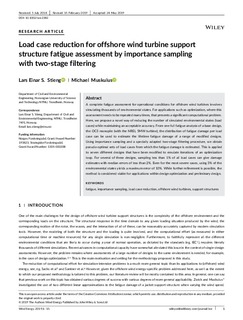| dc.contributor.author | Stieng, Lars Einar | |
| dc.contributor.author | Muskulus, Michael | |
| dc.date.accessioned | 2019-08-09T07:18:30Z | |
| dc.date.available | 2019-08-09T07:18:30Z | |
| dc.date.created | 2019-08-07T11:19:31Z | |
| dc.date.issued | 2019 | |
| dc.identifier.citation | Wind Energy. 2019, . | nb_NO |
| dc.identifier.issn | 1095-4244 | |
| dc.identifier.uri | http://hdl.handle.net/11250/2607675 | |
| dc.description.abstract | A complete fatigue assessment for operational conditions for offshore wind turbines involves simulating thousands of environmental states. For applications such as optimization, where this assessment needs to be repeated many times, that presents a significant computational problem. Here, we propose a novel way of reducing the number of simulated environmental states (load cases) while maintaining an acceptable accuracy. From one full fatigue analysis of a base design, the OC3 monopile (with the NREL 5MW turbine), the distribution of fatigue damage per load case can be used to estimate the lifetime fatigue damage of a range of modified designs. Using importance sampling and a specially adapted two‐stage filtering procedure, we obtain pseudo‐optimal sets of load cases from which the fatigue damage is estimated. This is applied to seven different designs that have been modified to emulate iterations of an optimization loop. For several of these designs, sampling less than 1% of all load cases can give damage estimates with median errors of less than 2%. Even for the most severe cases, using 3% of the environmental states yields a maximum error of 10%. While further refinement is possible, the method is considered viable for applications within design optimization and preliminary design. | nb_NO |
| dc.language.iso | eng | nb_NO |
| dc.publisher | Wiley | nb_NO |
| dc.rights | Navngivelse 4.0 Internasjonal | * |
| dc.rights.uri | http://creativecommons.org/licenses/by/4.0/deed.no | * |
| dc.title | Load case reducation for offshore wind turbine support structure fatigue assessment by importance sampling with two-stage filtering | nb_NO |
| dc.type | Journal article | nb_NO |
| dc.type | Peer reviewed | nb_NO |
| dc.description.version | publishedVersion | nb_NO |
| dc.source.pagenumber | 15 | nb_NO |
| dc.source.journal | Wind Energy | nb_NO |
| dc.identifier.doi | 10.1002/we.2382 | |
| dc.identifier.cristin | 1714535 | |
| dc.relation.project | Norges forskningsråd: 193823 | nb_NO |
| dc.relation.project | Andre: 1305-00020B | nb_NO |
| dc.description.localcode | © 2019 The Authors Wind Energy Published by John Wiley & Sons Ltd This is an open access article under the terms of the Creative Commons Attribution License. | nb_NO |
| cristin.unitcode | 194,64,91,0 | |
| cristin.unitname | Institutt for bygg- og miljøteknikk | |
| cristin.ispublished | true | |
| cristin.fulltext | original | |
| cristin.qualitycode | 2 | |

